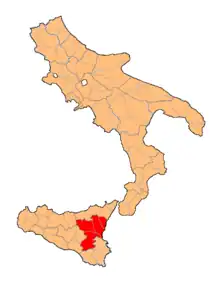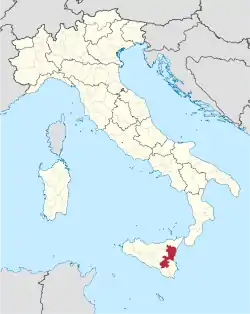Province of Catania
The Province of Catania (Italian: Provincia di Catania; Sicilian: Pruvincia di Catania) was a province in the autonomous island region of Sicily in southern Italy. Its capital was the city of Catania. It had an area of 3,552 square kilometres (1,371 sq mi) and a total population of about 1,116,917 as of 31 December 2014.[2]
| Provincia di Catania Val di Catania | |
|---|---|
| Province of the Kingdom of the Two Sicilies, the Kingdom of Italy and the Italian Republic | |
| 1818–2015 | |
 Map highlighting area and location of the province of Catania in Southern Italy until 1927 | |
 Map highlighting area and location of the province of Catania in Italy since 1927 | |
| Capital | Catania |
| Area | |
| • Coordinates | 37°31′N 15°4′E |
• 2014 | 3,552 km2 (1,371 sq mi) |
| Population | |
• 2014 | 1116917 |
| History | |
| History | |
• Established | 1 January 1818 |
• Royal Decree of the Kingdom of the Two Sicilies | 11 October 1817 |
| 11 June 1860 | |
• Disestablished | 4 August 2015 |
| Today part of | Metropolitan City of Catania |

Historically known also as Val di Catania,[lower-alpha 1] it included until 1927 a large part of the Province of Enna.
It was replaced by the Metropolitan City of Catania starting from 4 August 2015.
History
The Province of Catania was founded by Greeks, in 729 B.C. It was conquered by the Roman, in the First Punic War, in 263 BC.[3] It had experienced many volcanic eruptions from the Mount Etna, of which the first eruption was recorded in 475 BC.[4] It was hit by a devastating earthquake in 1169, which caused an estimated death toll of about 15,000 people in the city of Catania alone.[5] In 1669, it was also affected by the 1669 Etna eruption.[4] It was hit by another earthquake in 1693, which resulted in the death of about 12,000 people (63% population at the time).[6]
Geography
The province of Catania was one of nine provinces in the island of Sicily[7] which is the largest island in the Mediterranean Sea.[8] It met the Ionian Sea at the north-east. The Province of Caltanissetta and the Province of Enna lay to the west, the Province of Ragusa and the Province of Siracusa lay to the south, and the Province of Messina lay to the north. It also had the largest active volcano of Europe, Mount Etna. The provincial capital and largest commune was the city of Catania.[9]
Subdivisions
There were 58 comunes (Italian: comuni) in the province , see Comunes of the Province of Catania.
See also
Notes and references
Notes
- From Siculo-Arabic وَلاية walāya, with the administrative meaning of "province"; also used with the geographical meaning of "valley", relating it to Latin vallis. Compare Val di Noto.
References
- Raccolta degli Atti di Governo dittatoriale e prodittatoriale in Sicilia - 1860 [Collection of the Dictatiorial and Pro-Dictatiorial Government Acts in Sicily of 1860] (PDF), Palermo: Francesco Lao, 1861, p. 45, retrieved 2020-02-08
- "2014 Istat census".
- Inc, Merriam-Webster (1997). Merriam-Webster's Geographical Dictionary. Merriam-Webster. p. 222. ISBN 9780877795469.
{{cite book}}:|last=has generic name (help) - "Mount Etna erupts - Mar 08, 1669 - HISTORY.com". HISTORY.com. Retrieved 2017-09-18.
- Falcando, Ugo (1998). The History of the Tyrants of Sicily by "Hugo Falcandus," 1154-69. Manchester University Press. p. 216. ISBN 9780719054358.
- "Informazioni sul terremoto". storing.ingv.it. Retrieved 2017-09-18.
- Klotz, Stefan (2004). Cross Sectional Dependence in Spatial Econometric Models: With an Application to German Start-up Activity Data. LIT Verlag Münster. p. 135. ISBN 9783825879181.
- Diamond, Jon (2017). The Invasion of Sicily 1943. Pen and Sword. p. 44. ISBN 9781473896123.
- Domenico, Roy Palmer (2002). The Regions of Italy: A Reference Guide to History and Culture. Greenwood Publishing Group. pp. 283–284. ISBN 9780313307331.

